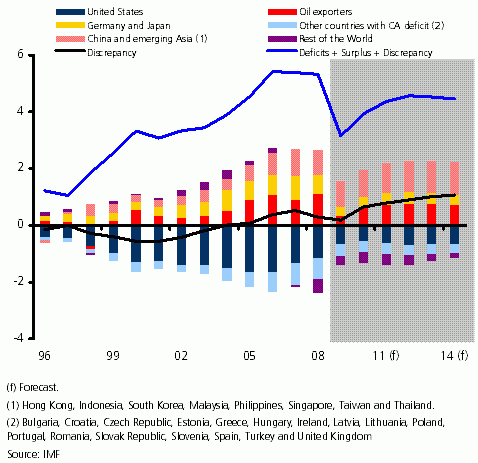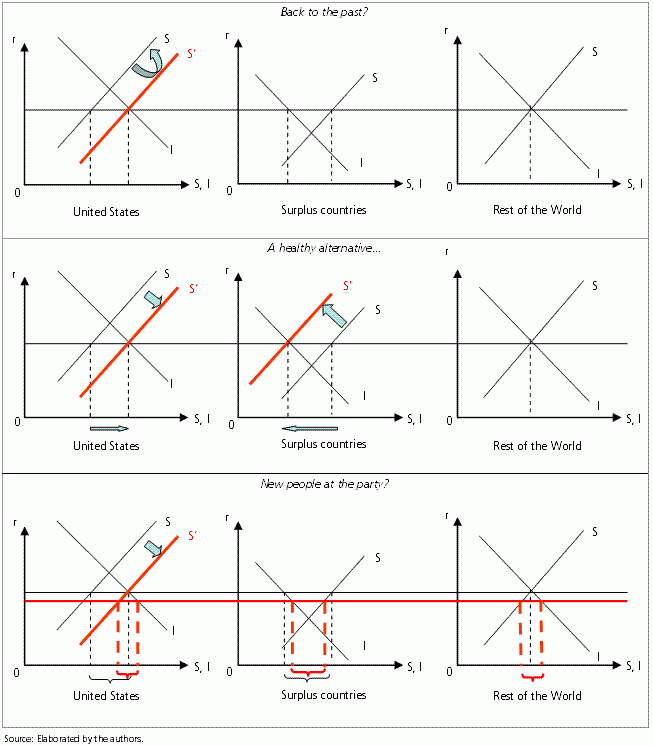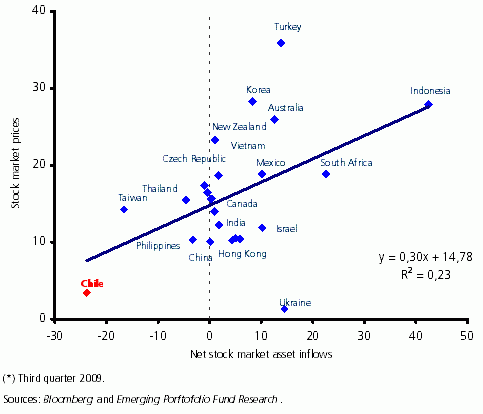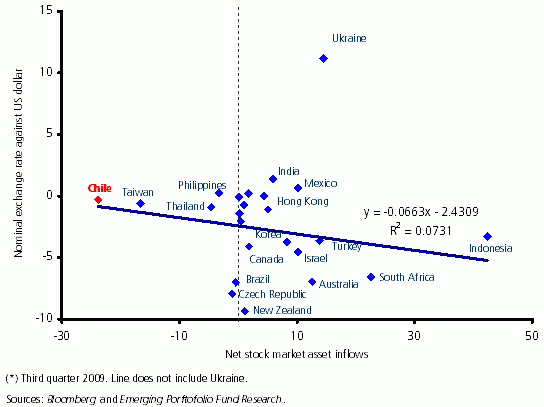So-called global imbalances, or the persistence of current account deficit in the US and other high income countries matched by the surplus of others such as China, have been identified as one of the major causes of the current crisis (Bernanke 2009 among others). The presence of excess liquidity ended up inflating prices of financial assets to unsustainable levels in the US and other major economies as well as international commodity prices (Obstfeld and Rogoff 2009).
For the time being the collapse of international trade (Baldwin 2009) has helped to reduce the size of imbalances. Yet looking forward, the future trajectory of global imbalances is unclear. In a recent paper, Blanchard and Milesi-Ferretti (2009) argue that, while global imbalances have reduced, reducing them further would be beneficial to the world economy as the imbalance may threaten the sustainability of the recovery.
Two major questions remain unresolved:
- First, does the reduction of global imbalances reflect a transitory or a more permanent shift?
- Second, directly related to the first, which form will the economic and financial landscape take regarding global capital flows?
Regarding the first question, a number of observers, argue that the reduction in global imbalances is transitory. Baldwin and Taglioni (2009), in a column on this site, argue that the improvements in global imbalances are mainly the transitory side-effect of the large trade collapse recently experienced by the world economy, and once global growth resumes, global imbalances are likely to re-emerge as well. The IMF in its October 2009 World Economic Outlook, forecast a widening of the global imbalances towards 2014, albeit not as big as the immediate pre-crisis level. Its forecast of a reduction of the deficits in the countries with chronic deficit is not matched by a reduction of surpluses of countries with chronic surplus. The resulting gap is subsequently closed by an increase of errors and omissions (Figure 1).
Figure 1. Global imbalances as a share of World GDP
A three scenario analysis
We think the IMF forecast provides a useful framework to think about this problem. We suggest three alternative scenarios for the “absorption” of the forecast errors and omissions. This analysis was also explored in depth in chapter 1 of the most recent financial stability report at the Central Bank of Chile (2009).
Since balance of payments of all countries are required to sum zero on a global scale, the capital reflected in the errors and omissions account of the IMF forecast will eventually be shared by one or more countries.1 Three potential scenarios result; deficit countries increase their deficit, surplus countries reduce their surplus, or finally, another group of countries that so far, have not been the centre of the discussions around the global imbalances, becomes the recipient of the excess liquidity and start running increasing deficits. Naturally, combinations of these three scenarios are also possible. Figure 2 describes these three possible scenarios for the evolution of the global imbalances through a simple framework based on the path of private savings in three different groups of countries. (For simplicity, this framework assumes unchanged government savings and private and government investments. Different assumptions for the path of these variables can be easily incorporated but go beyond the scope of this note).
Figure 2. Global imbalances scenarios
Back to the past?
If the surplus countries do not adjust, one possibility is that the errors and omissions go to finance consumption of the deficit countries. This would signal a return to the old imbalances. The same kind of imbalances would probably lead to problems similar to those which led to the current crisis – only much faster, and probably deeper. The flow of cheap capital would stimulate consumption again, but deficit countries are already highly leveraged, so a shorter time would ensue before the new environment becomes unsustainable.
A healthy alternative?
China and other chronic surplus countries may adopt policies to stimulate higher domestic consumption and lower savings. This would keep global imbalances smaller as trade may not recover to levels as high as previously observed. World growth, however, is likely to be lower in this scenario as the total size of the chronic surplus countries’ economies is significantly smaller than the total size of the economies with chronic deficit. We believe that the possibility of the errors and omissions being reduced by the lower surplus of China is remote in the medium term. First, it may take time for China to move away from an export-oriented economy to one mostly based on domestic demand and second, the impact on its growth rate would be uncertain. Moreover, there are still other surplus countries like the oil-exporting ones. But due to their size, even if they adjust, it is unlikely to be enough to diminish errors and omission forecast in a significant way.
New people at the party?
A third possibility, neglected so far but, in our opinion, likely to gain traction, is that the errors and omissions go to a different group of countries; countries which have been ancillary to the action and outside the core discussion of global imbalances. This could result if the currencies in deficit countries appreciate, leading to less competitive exports and deteriorating their balance of payments. Capital flows to these countries may inflate assets prices and overheat their economies. Figure 3 shows that countries that received the larger capital inflows to portfolio equity investments during the third quarter of 2009 saw their equity markets increase by a larger margin. In the context of this scenario, several macroeconomic risks emerge for this group of countries and their governments, which would face difficult policy dilemmas so as to mitigate the negative effects on the economy.
Figure 3. Net asset inflows and stock market prices* (% variation in dollars, share of initial stock)
Policy implications for emerging market economies
In our third scenario, large and sustained capital inflows will test emerging markets’ ability to absorb foreign capital without distorting prices in their national economies. Beyond emerging countries, Australia, New Zealand, Canada and other economies may also face similar challenges from large capital inflows.
The exchange rate regime will be pivotal in shaping the policy implications faced by each economy. On one hand, economies with flexible exchange rate regimes are likely to see their currencies appreciate over time, creating problems of competitiveness for their export sector. Figure 4 shows that currencies of countries that received the larger capital inflows to portfolio equity investments during the third quarter of 2009 appreciate the most. Given the exports’ sector importance and political influence, governments of these countries may face pressures favouring foreign exchange intervention to reduce foreign exchange volatility. This intervention may take the form of direct purchases of foreign exchange in the market or indirect capital controls aiming to discourage capital inflows. Measures liberalising capital outflows may also be considered as a tool to mitigate exchange rate appreciation. On the other hand, economies with more rigid exchange rate regimes are likely to see their credit expand rapidly, creating risks of overheating the economy and increasing inflationary pressures.
Figure 4. Net asset inflows and nominal exchange rate against the dollar (% variation, share of initial stock)
Bottom line
Attributing a high probability to scenario 3, we believe that policy challenges in emerging economies will abound in the near future. Navigating through the different options will not be trivial and capital controls in several countries could re-emerge after years of ostracism as a policy instrument. Brazil and Taiwan are among economies which have recently taken the first steps in this direction.
The views expressed herein are those of the authors and not necessarily those of the Central Bank of Chile and the IMF.
Footnotes
1 Nonetheless, some errors and omissions are always expected to remain in place given institutional capacity problems of data collection in several countries, which may arise from, among others, under- and over-reporting of exports and imports and informal capital account transactions (capital flight).
References
Baldwin, Richard (2009), The Great Trade Collapse: Causes, Consequences and Prospects, VoxEU.org Ebook, 27 November.
Baldwin, Richard and Daria Taglioni (2009), “The illusion of improving global imbalances”, VOX.org, 14 November 2009.
Bernanke, Ben S (2009), “Financial Reform to Address Systemic Risk”, Speech at the Council on Foreign Relations, Washington, DC, 10 March.
Blanchard, Olivier and Milesi-Ferretti, Gian M. (2009),“Global Imbalances: In Midstream?”, IMF Staff Position Note, December.
Central Bank of Chile (2009), “Financial Stability Report – December 2009”.
International Monetary Fund (2009), “World Economic Outlook”, October.
Obstfeld, Maurice and Kenneth Rogoff (2009), “Global Imbalances and The Financial Crisis: Products of Common Causes”, Paper prepared for the Federal Reserve Bank of San Francisco Asia Economic Policy Conference, Santa Barbara, CA, October 18-20.







